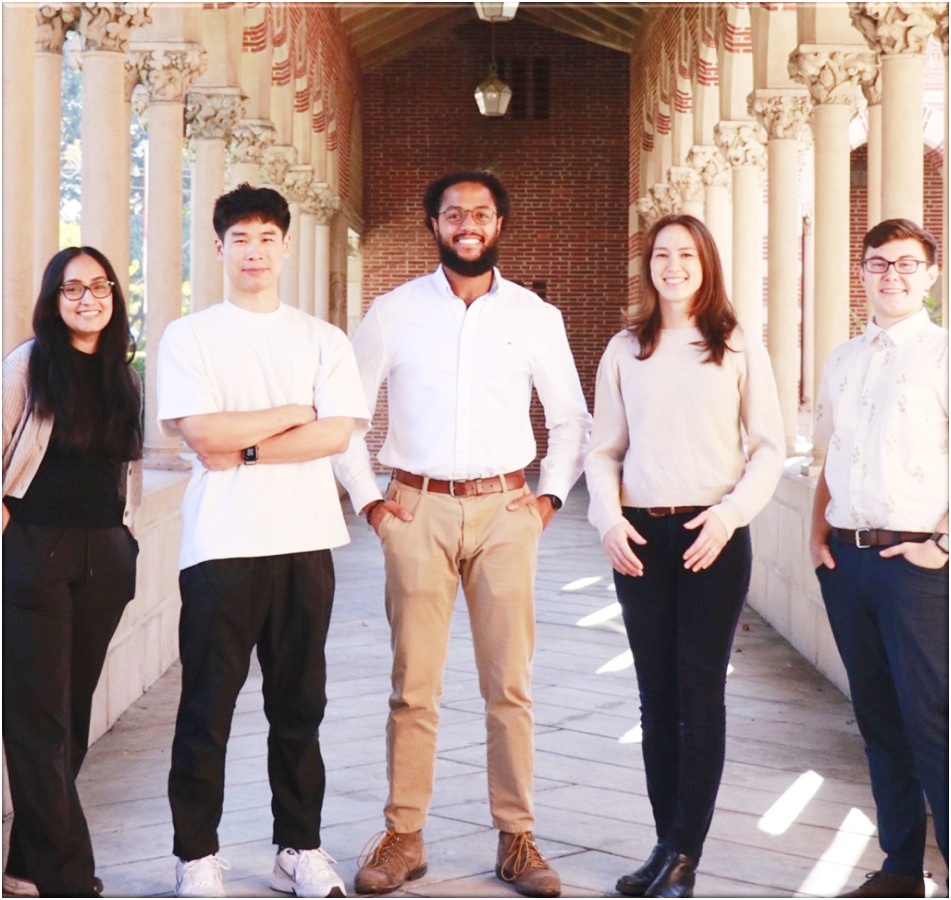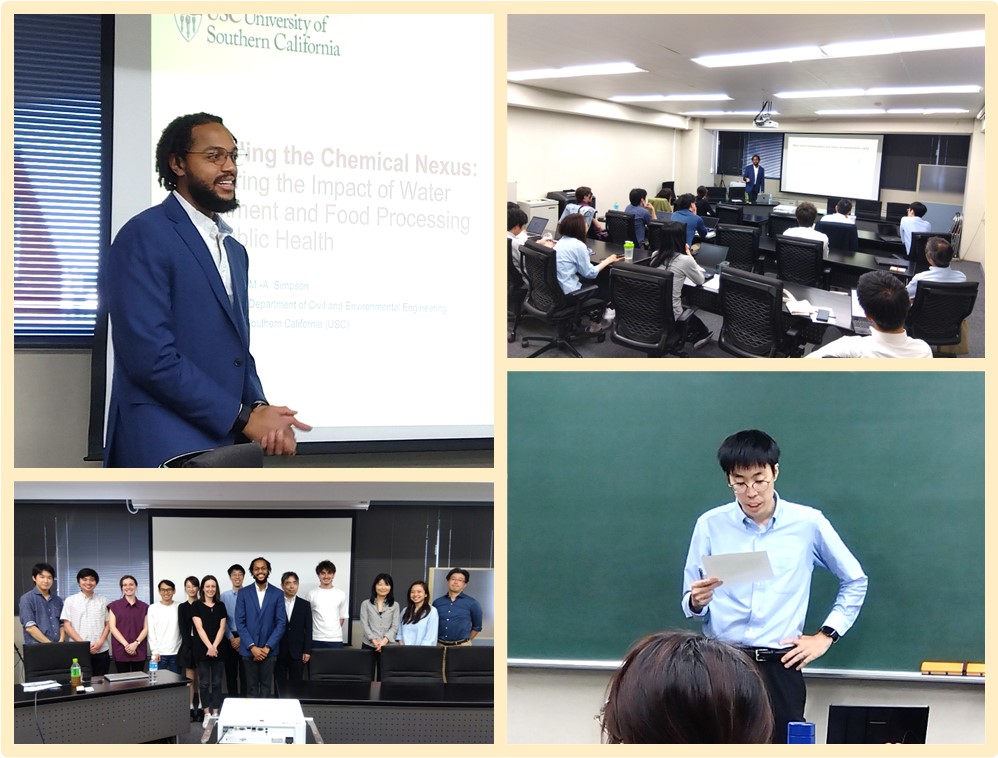RECWET Special Seminar Series #65

Dr. Simpson’s Research Group: (L-R)
Sanaiya Islam, Lang He, Dr. Adam Simpson,
Lisa Staugaard, and Jacob Damrow.
Date and Time: 10:30-12:00, Apr 21 (Mon) 2025
Place: Room 802 meeting room (8F, Eng building 14)
“Unveiling the Chemical Nexus: Exploring the Impact of Water Treatment and Food Processing on Public Health”
By: Adam M.-A. Simpson
Assistant Professor
University of Southern California, US
Viterbi School of Engineering
Sonny Astani Department of Civil & Environmental Engineering
Lab website
Google Scholar
Two more professors attended the lecture.
The urban environment encounters distinct challenges at the intersection of the food, energy, and water nexus. In the western United States (US), numerous regions are struggling to secure safe drinking water for major urban centers, such as Los Angeles, CA, which is the second largest city in the country. The USC ReWater Center addresses global water supply challenges using innovative technologies, strategic visions, and the dedicated efforts of our community. Its goal is to reshape the narrative surrounding water scarcity.
In this talk, Assistant Professor Adam Simpson will first provide an overview of the center’s work and introduce the faculty and students conducting research. He will then pivot to two thrusts of his own research group.
First, environmental engineers must balance the risks of pathogens and disinfection byproducts (DBPs) in drinking water. While US EPA-regulated DBPs (like trihalomethanes and haloacetic acids) comprise just a tiny fraction of the 700 identified DBPs, low-molecular-weight aliphatic DBPs, which contain 1-2 carbon atoms, account for 30% of total organic halogen (TOX) in chlorinated water. Toxicological studies indicate that these DBPs may represent only 17% of total cytotoxicity, leaving much uncharacterized. Recent research suggests that halogenated phenolic compounds (halophenols) are significant cytotoxic DBPs. Our group utilizes the Chinese hamster ovary (CHO) cell chronic cytotoxicity assay to assess the toxicity of individual contaminants, such as halophenols, and mixtures of contaminants. This ongoing study will focus on 16 chlorinated and brominated halophenols, aiming to: 1) assess the influence of halogen positioning and other functional groups on toxicity (LC50), 2) evaluate the additive effects of halophenol mixtures on CHO cells, and 3) utilize artificial intelligence to create robust statistical assessment protocols for toxicological analysis in comparison to previously published protocols. Our goal is to enhance environmental engineers’ use of the CHO cell chronic cytotoxicity assay to evaluate the overall health quality of water sources and newly identified contaminants.
Additionally, researchers link 40% of cancer diagnoses in the US to obesity-related factors, which may be influenced by exposure to chemicals that lead to both obesity and cancer. However, there is no direct evidence connecting processed food chemical exposure to these statistics. The US EPA regulates DBPs in drinking water, some of which are linked to bladder cancer. In contrast, the food industry uses chemical oxidants, like free chlorine, at levels 10,000 times higher than those allowed in water treatment. Our research indicates that chlorine washing and bleaching practices incorporate chlorine into food components, producing more toxic compounds than those created during drinking water treatment. This study will examine the bleaching of tree nuts using up to 60,000 mg/L as Cl2 as an economically interesting food commodity. We hypothesize that up to 47% of the unsaturated fatty acids in these nuts will convert into highly toxic fatty acid chlorohydrins. Our goal is to propose a new perspective that views food as having a "chemical memory" from past processing rather than being inert materials.
[Biography]Dr. Adam Simpson is an Assistant Professor of Civil and Environmental Engineering at the University of Southern California, where his research focuses on food contaminants and complex matrices. His lab is particularly interested in applying environmental engineering principles to investigate the intensive oxidative processes used in the food industry. Drawing from his training in water disinfection byproducts, he aims to uncover toxic contaminants in foods.
Dr. Simpson earned his MS and PhD in Civil and Environmental Engineering from Stanford University in 2018 and 2022, respectively. He was advised by Dr. William A. Mitch during his time there. Prior to his graduate studies, Dr. Simpson earned his BS in Chemical Engineering from Carnegie Mellon University.
His diverse experiences include a year-long position at the United States Department of Agriculture – Agricultural Research Service, where he worked under staff environmental chemist Dr. Spencer Walse. After this, Dr. Simpson returned to Stanford, where he was an IDEAL Provostial Fellow focusing on Race and Ethnicity. During this fellowship, he continued his research on food while collaborating with sociologists and public health scholars. He also became a fellow of the Multiscale RECIPES for Sustainable Food Systems network. Additionally, he learned the chronic cytotoxicity assay using Chinese hamster ovary cells at Cornell University under Professor April Gu.
Born and raised in Jamaica, Dr. Simpson is eclectic and artistic, following a vegan diet. He is married to his high school sweetheart, Vicki, and enjoys painting, running, and spending time with their pet cat, King H’abibi. This is his second visit to Japan, returning after 19 years.
Shotaro Torii, Assistant Professor,
Department of Urban Engineering

